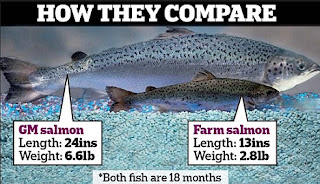Wednesday, October 10, 2012
Genetically Modified Salmon
1. Madin E., 2011. Genetically Engineered Salmon Pose
Environmental Risks That Must Be Considered. [Online]
Available
at: http://search.proquest.com.ezproxy.library.uq.edu.au/docview/861491933
[Accessed
9/10/2012]
2. O’neil
C. & Kimbrell A., 2011, Biotechnology: US Congress right to halt GM salmon,
Centre for Food Safety, Washington DC, 476: 283. [Online]
Available
at:
http://cf5pm8sz2l.search.serialssolutions.com/?ctx_ver=Z39.88-2004&ctx_enc=info%3Aofi%2Fenc%3AUTF-8&rfr_id=info:sid/summon.serialssolutions.com&rft_val_fmt=info:ofi/fmt:kev:mtx:journal&rft.genre=article&rft.atitle=US+Congress+right+to+halt+GM+salmon.%28CORRESPONDENCE%3A+COMMENT%29&rft.jtitle=Nature&rft.date=2011-08-18&rft.pub=Nature+Publishing+Group&rft.issn=0028-0836&rft.volume=476&rft.issue=7360&rft.spage=283&rft.externalDBID=n%2Fa&rft.externalDocID=265373514
[Accessed
8/10/2012]
3. Reece J., Meyers N., Urry L.,
Cain M., Wasserman S., Minorsky P., Jackson R., & Cooke B., 2012, Campbell
Biology, 9th ed, Pearson Education, Australia [Book]
[Accessed 7/10/2012]
4. Thompson P., 2012. The GMO Salmon Struggle: FDA May for First Time Ever Approve Genetically Modified Animal for Human Consumption. [Online]Available at: http://scienceprogress.org/2011/09/the-gmo-salmon-struggle/
Wednesday, March 28, 2012
Genetics of body shape: Apple or Pear?
Genetics of body shape: Apple or Pear?
New recent scientific study discovered that genetics play a significant role in body fat distribution and determines whether your body shape is “apple” or “pear”. These genetic variants have different health implications dependent on the fruit-based analogies of body shape. Moreover, it was found that a genetic variation relevant to fat distribution has much stronger effects in women than in men.
An international team of scientists, led by the Medical Research Council and Oxford University identified the biological processes that are associated with fat distribution and obesity.
Figure 1 Waist-to-hip ratio and a nucleotide polymorphisms
They discovered that DNA variations could be connected to waist-to-hip ratios. They found 13 single nucleotide polymorphisms associated with body fat distribution. These DNA regions are involved in regulating cholesterol, triglyceride levels and insulin.
Figure 2 Body mass index (Phoenix evolution)
Moreover, they investigated the genes that have correlation with Body mass index. BMI is a measure commonly used to classify adults. BMI of 25 to 30 is accepted to be overweight and a BMI of 30 or higher is known to be obese. From this research, 18 new genetic regions that are associated with increased susceptibility to obesity were discovered.
Also, a studied investigation has proven a trend that those who inherit a larger amount of BMI-increasing genes from their parents have weights 7-9kg more than those who don’t inherit as much of these genes. This variation in weight is entirely the causation of different genes different people have.
Figure 3 Apple shape vs. pear shape
These genetic variants have different health implications by looking at the body shape fruit-based analogies to describe body shape. For those who don’t know yet, “apples” tend to carry more weight around their waist whereas “pears” tend to be heavier around the hips and thighs.
Unfortunately, for the apples, their susceptibility to accumulate excess fat around the waist region puts them at a greater risk of causing a type of heart disease and type 2-diabetes. On the other hand, “pears” thought to be offering some protection against high blood pressure and diabetes.
Figure 4 Distribution of fat in males and females
The results from the research state that there is dissimilarity in fat distribution between the sexes. It is because, 12 of 14 SNPs are associated with body fat distribution whereas there are only three of 14 SNPs in men.
Where the body fat lies in the body is a crucial role in causing diseases. A better and improved understanding of the risks that genetic facture underlying increase waist and hip size may aid in allowing for quicker remedies and therapies.
BIBLOGRAPHY
Medical Research Council - News - Apple or pear? New insights into the genetics of body shape. 2012. Medical Research Council - News - Apple or pear? New insights into the genetics of body shape. [ONLINE] Available at: http://www.mrc.ac.uk/Newspublications/News/MRC007403. [Accessed 21 March 2012].
Press Release - 23andMe Presents Top Ten Most Interesting Genetic Findings of 2010 - 23andMe. 2012. Press Release - 23andMe Presents Top Ten Most Interesting Genetic Findings of 2010 - 23andMe. [ONLINE] Available at: https://www.23andme.com/about/press/23andme_presents_top_ten_most_interesting_genetic_findings_of_2010/. [Accessed 21 March 2012].
European Journal of Human Genetics - Genome-wide analysis of epistasis in body mass index using multiple human populations. 2012. European Journal of Human Genetics - Genome-wide analysis of epistasis in body mass index using multiple human populations. [ONLINE] Available at: http://www.nature.com/ejhg/journal/vaop/ncurrent/full/ejhg201217a.html. [Accessed 21 March 2012].





